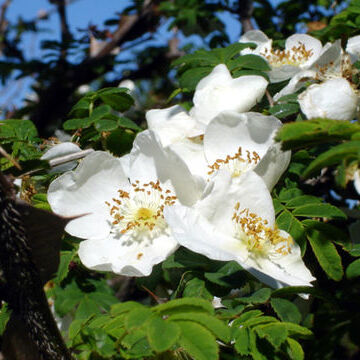Shrubs erect, 1–2 m tall. Branchlets robust; prickles absent or in pairs below leaves and scattered, terete, to 1.2 cm, fine to robust, abruptly flaring to a broad base, or prickles winglike, to 1.2 cm and 3.5 cm in diam.; bristles sometimes dense. Leaves including petiole 3.5–8 cm; stipules mostly adnate to petiole, free parts auriculate, pubescent or glabrous, margin glandular; rachis and petiole pubescent, sometimes sparsely prickly and glandular-pubescent; leaflets (5–)7–11(–13), ovate or obovate, rarely obovate-oblong, 8–20 × 5–8 mm, abaxially sericeous-villous or subglabrous to glabrous, glandular or not, adaxially glabrous, rugose, base broadly cuneate, margin serrate in upper part, entire below, apex rounded-obtuse or acute. Flower solitary, axillary, 2.5–5 cm in diam.; pedicels 1–2 cm, glabrous; bracts absent. Hypanthium obovoid or globose, subglabrous. Sepals 4, ovate-lanceolate, abaxially sparsely pubescent or subglabrous, adaxially villous, margin entire, apex acuminate or acute. Petals 4, white, broadly obovate, base broadly cuneate, apex emarginate. Styles free, shorter than stamens, slightly exserted, villous. Hip red or purple-brown, obovoid or globose, 8–15 mm in diam., glabrous, with persistent, erect sepals; pedicel 1–2 cm, glabrous, usually not fleshy. Fl. May–Jun, fr. Jul–Aug. 2n = 14.
More
A shrub. It is spiny with many branches. It grows about 2-3 m high. It spreads 2.4 m wide. The prickles are brown and straight. The leaves have stalks. The leaves are divided into an odd number of leaflets. There are normally 7-9 leaflets with short stalks. These are oblong and with teeth towards the tip. They have long, soft hairs, often on both surfaces. The flowers are in the axils of leaves. They occur singly on side shoots. They are white or yellowish. The fruit is round or pear shaped. It is red. The fruit are edible.
Forests, shrubberies and alpine slopes; at elevations up to 4,500 metres. Sparse woods, forest margins, scrub, valley slopes, dry valleys, cliffs, mountain summits, gravels, dry sunny places; at elevations from 2,000-4,400 metres.
More
A temperate plant. In Nepal plants grow between 1700-4200 m altitude. In the Indian Himalayas it grows between 2,700-3,000 m above sea level. They grow in exposed places. It suits hardiness zones 6-10. In Sichuan and Yunnan.

